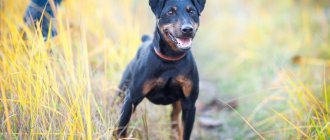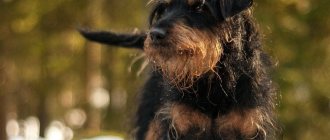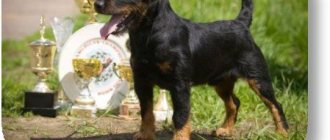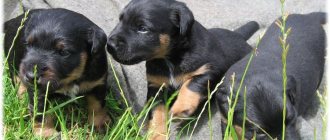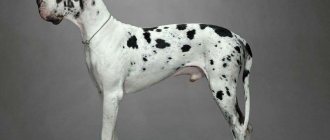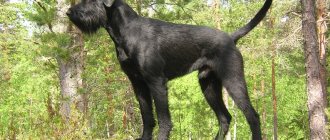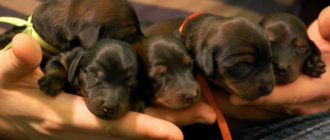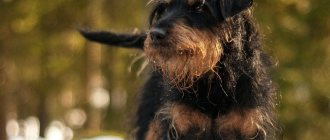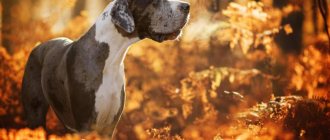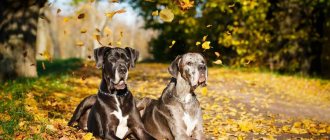History of the German Jagd Terrier breed
The breed was formed at the beginning of the 20th century, when dog breeders, fed up with show terriers, began to dream of working pets that could bring real benefits.
By that time, European exhibitions were filled with representatives of the group with an exemplary exterior, but absolutely unsuitable for working on the animal due to muted instincts. After the First World War, German specialists began breeding a new, purely hunting variety of terrier, ideally working in a hole. The pioneer in this matter was the dog breeder and part-time passionate fan of fox terriers Walter Zangenberg, who was later joined by Rudolf Fries and Karl-Erich Grunewald. The breeder began his experiments by taking four fox terrier puppies from the director of the Munich Zoo, Lutz Heck. Zangenberg was not embarrassed that the babies had a vicious black and tan color, since the breeder intended to develop hunting instincts in the animals, and not a glamorous appearance. As a result, the matured puppies were bred with black foxes, known for their phenomenal viciousness and tirelessness in pursuing prey.
Smooth coated German Jagdterrier
Wirehaired German Jagdterrier
In 1926, the first Jagdterrier club opened in Germany, and 12 months later Zangenberg’s charges began to be exhibited at an exhibition. At first, the breed was bred by inbreeding (inbreeding), which did not have the best effect on the health of the offspring. And only in the 20s did dog breeders begin to involve more distant relatives - Welsh Terriers and Old English Terriers - in training jags. After World War II, breeding of the breed was no longer as active, which was facilitated by the division of Germany into occupation zones. In addition, the breeders of the GDR relied on Zangenberg’s breeding research, that is, they continued to cross Jagd relatives with each other. As a result, the dog population quickly recovered, but the number of defective individuals began to grow exponentially.
International recognition came to the Jagdterrier in 1954, along with the receipt of the FCI standard. After this event, dogs began to be exported to North and South America, but the small and nimble jags did not make the right impression on the hunters of the New World. German terriers were brought to the USSR in the 70s, although unofficial sources claim that the first acquaintance of domestic breeders with the breed took place 40 years earlier. Of the manufacturers imported to the Soviet Union, Cherry von Rischebach, Dina von Hochlitzee, and Encke von Wolzi-Gersee are especially noteworthy. It was these individuals that laid the foundation for the first generations of Russian Jagd Terriers.
Interesting Facts
- Even in the 19th century, the level of hygiene and sanitation left much to be desired. Even students at the famous University of Cambridge had to buy small rat-catching terriers to get rid of rodents.
- In England, fox hunting could last from one to several days. Therefore, hunters often borrowed a terrier from a nearby farm, or brought the dog in their pocket. Therefore, such terriers were called “pocket”.
- The courage and boundless courage of the Irish Terrier was put to good use during the First World War, when these selfless dogs officially served with the British troops, delivering important messages and helping to find the wounded.
- At one time, the Kerry Blue Terrier had another name - “Blue Devil”. The fact is that breeders initially developed aggressiveness in dogs of this breed as a distinctive character trait. Kerry Blue Terriers with insufficient levels of aggression were not even allowed to participate in dog shows.
Video: All about the breed - Jack Russell Terrier
Tweet
Breed standard German Jagd Terrier
German Jagd Terrier puppy
Like a real hard worker, not used to lying on the sofa and posing for the camera, the Jagdterrier cannot boast of either a stylish satin “fur coat” or a particularly sweet appearance. However, he doesn’t need this, since the vast majority of owners of the breed are practical people who demand professional skills and an exciting hunting show from their pet, but are absolutely indifferent to the exterior of their ward. Accordingly, the correct German Jagdterrier is first a hardy and strong breadwinner, and only then a friend, companion and everything else.
The standard height of a yagda ranges from 33-40 cm, and these figures apply equally to both females and males. But the weight categories of dogs of different sexes are different. Female jags weigh from 7.5 to 8.5 kg, while males are able to build more voluminous muscle mass, maintaining a weight between 9 and 10 kg.
Head
The head of the German Jagd Terrier appears moderately elongated with clearly defined cheekbones and a developed chin. The skull is flattened, quite spacious in the area between the ears. The muzzle is shorter than the head, without strong pointedness, with a slight stop.
Jaws, lips, teeth
Representatives of the breed have massive jaws, closed in a complete scissor bite, hidden by brightly pigmented dense lips. The teeth are large, set evenly, in the amount of 42 pieces.
Nose
Dimensions of the German Jagd Terrier
The dogs have a harmoniously developed, small nose, predominantly black in color. A brown tint is acceptable for individuals with the same coat tone.
Eyes
The German Jagdterrier is a dog with a determined, direct look. The animal's eyes are small, oval, located at a distance from each other, which minimizes the risk of damage from the paws of forest predators.
Ears
The ear flap of a purebred Jagda is set high, has medium dimensions and a regular triangular shape.
Neck
According to the FCI standard, animals must have strong necks of normal length, gradually turning into shoulders.
Muzzle of a German Jagdterrier
Body
The German Jagd Terrier is a compact breed. Mandatory condition: the girth of the dog’s sternum should be 10-12 cm greater than its height at the withers. The body length also exceeds the height at the withers, but only slightly. The top of the body is straight, with a muscular loin and an impressive horizontal croup. The animal's chest should be deep, with arched ribs laid back. The line of a slightly tucked belly, which has a graceful curve, looks very elegant.
Limbs
King of the Hill
A prerequisite for the legs of a German Jagd Terrier is that they are parallel to each other when viewed from the front and rear. In addition, the limbs must have strong bones and dry muscles. The shoulder blades are elongated, oblique, with developed muscles. The elbows are located close to the body without obvious turning in any direction. The forearms are steep and straight.
The dog's hind legs look more substantial due to the elongated, moderately wide hips. Elongated sinewy shins, short vertical metatarsals and strong hocks are responsible for the springy push in movement. The round-oval paws of the yagda are “reinforced” with hard, intensely pigmented pads, and the front paws are noticeably larger than the hind paws. When standing and walking, the paws should not turn inward (clubfoot) or outward.
Tail
Jagdterriers living in countries where docking is prohibited have long, straight or saber-shaped tails. Such a tail is carried horizontally or barely raised at the top. Working dogs in Russia have their tail docked at ⅓. In this case, it takes a slightly raised, but not vertical position. In addition, the tip of the last vertebra should not deviate towards the back, since in burrow hunting conditions the tail plays the role of a “handle”, by which the owner can pull an angry dog out of an underground tunnel.
Wool
German Jagd Terriers come in two varieties: wire-haired and smooth-haired. In both cases, the outer hair has a coarse, dense structure, which helps the dog not get wet in rainy weather and protects the body from mechanical damage during hunting.
Color
Today's German Jagd Terrier is a brown, black, or grayish-black dog with tan markings on the chest, legs, muzzle, under the tail, and on the eyebrows. Acceptable features: the presence of dark and light masks on the face, the presence of tiny white spots on the toes and chest.
Brown Jagdterrier
Disadvantages and disqualifying vices
External features that do not fit into the parameters specified by the standard are positioned as exterior defects. There can be many such shortcomings, ranging from an overly pointed muzzle to splayed toes. If an animal is found to have behavioral and developmental defects that cover its breed qualities, this is almost always disqualification from the exhibition. The most common disqualifying defects of Jagd Terriers:
- different eyes, iris blue or speckled;
- malocclusions, including misalignment of the jaws and incorrectly positioned incisors;
- incomplete dental formula (the absence of M3 does not count);
- inversion or inversion of the eyelid;
- non-standard pigmentation of the earlobes, lips, paw pads;
- too tall or short;
- weak character, fear of shots and wild animals.
Kinds
Manchester Terrier: description of the English dog breed
There are two main types of this breed:
- longhaired or wirehaired;
- short-haired or smooth-haired.
Scientists also identify an additional or intermediate option, also known as brocken. In this case, the dog has partially combined wire-haired and smooth-haired fur.
The color can be pure black and brown or black and brown with a slight white streak.
Smooth-haired
The smooth-haired Jagdterrier has thick, dense fur. There is no undercoat, the fur just fits tightly to the body. The hair on the body is evenly distributed and looks neat and well-groomed. Externally, such fur looks shiny, especially in the sun.
Smooth-haired
Wirehaired
The Wirehaired Jagdterrier has thicker, denser and longer fur. A small shaggy beard forms on the muzzle. This feature is what primarily distinguishes the species from smooth-haired ones. The fur is hard to the touch.
The appearance of this type of dog is rather sloppy. In addition to the beard, there are elongated hairs on the paws and belly. Elongated eyebrows also stand out well above the eyes.
Photo of a German Jagdterrier
Character of the German Jagd Terrier
It is important to understand that the German Jagd Terrier does not exist outside of hunting, so buying a dog for yourself, children, or “for the sofa” and expecting aristocratic manners from it is not the most logical thing to do. However, even a yagd who regularly goes into the forest and works on animals is still obstinate. So say goodbye to the dream of making your pet an obedient “deliver” of slippers - this breed loves to cooperate, but not to serve and fawn.
The one who stole my heart
It is believed that professional training and early education can dampen the aggression and stubbornness of German Jagd Terriers, but there are also nuances here. Yes, a dog can be weaned from the habit of attacking strangers, but even an experienced dog handler will not be able to make him fall in love with a cat or another pet furry dog. Berries also attack small wild animals. For example, in rural areas, one of the main victims of the breed are hedgehogs. The black-and-tan “gladiators” are not stopped by either needles or the injuries they cause - reprisals against the prickly enemy are carried out immediately and to the bitter end.
It's the same story with unfamiliar dogs. German Jagdterriers have a strategic reserve of courage and the same amount of recklessness, therefore they are capable of provoking a conflict with their fellow tribesmen without any reason. The breed also has no time to understand the hierarchical system of the canine world, so even Yagd puppies easily go to extremes, such as encroaching on someone else’s bone or furiously attacking an adult wolfhound. Moreover, the larger the opponent, the more chances he has to infuriate the terrier - the impressive size of the opponent evokes a mixture of black envy and hatred among the “Germans”.
In a relationship with a person, Yagd prefers not to be scattered, but to concentrate on one person. Usually this is the one with whom the animal goes baiting and hunting. The dog recognizes the rest of the family members insofar as it is not in a hurry to fulfill their demands. The companion qualities of the breed are also tied to working instincts. The Jagdterrier will behave obediently during a walk only if there is someone nearby under whose leadership the animal is accustomed to hunting game. With all other household members, “feedback” will be episodic, so you can let your ward off the leash in the park in one and only case - if this park belongs specifically to you and there is not a single representative of wild fauna in it.
Description
The public received the German Jagderier warmly, inviting breeders to participate in exhibitions and present their work for public viewing. The pet had not only the characteristics of a hunter, but also an attractive appearance and small size.
No matter how serious a dog is, it is a favorite for many owners not only for its tracker qualities, but also simply because any animal gives joy with its childishness.
The appearance of the pet varies slightly, which allows some species to be presented on the pillow, and others - only as serious hunters, while the height and weight of both must correspond to generally accepted standards in both cases.
In the first option, no matter how trained the dog is, the main thing is its color, length of fur and other visual advantages. Hunters prefer an option that is less picky about grooming - short, coarse hair, minimal height so that the dog can easily climb into a hole and the absence of white spots; this nuance makes the game nervous.
According to their purpose, Jagdterriers are divided into the following types:
- official;
- fighting;
- decorative;
- sentinels;
- hunting
Education and training
The German Jagdterrier is a breed that needs to be raised “yesterday.” It is recommended to use traditional methods, but with an eye on the yagds’ tendency to dominate, which is expressed in biting family members, suppressing other animals, and attacking random passers-by. So, in the process of training, do not forget to instill in the dog respect for yourself and your household, showing it that the boss’s chair has been occupied for a long time.
Gentleman on a walk
Intellectually, the Yagdas may not be geniuses, but they are quite smart comrades, so they do not have any difficulties remembering commands. At the same time, perfect adherence to the “charter” is not their strong point. As an example: it is possible to train a German Jagd Terrier OKD in six months, but it is pointless to demand from him the endurance and diligence of a German Shepherd. Moreover, you should be lenient towards your pet’s mistakes: after all, you chose the ideal hunter, not a circus performer and watchman. However, you shouldn’t condone it either. Basic OKD commands will later come in handy when hunting, since they can be used to control the dog’s behavior.
The critical age for representatives of the breed is 6 months. It is during this period that the German Jagd Terrier begins to test the owner’s patience with renewed energy. There is no need to cancel the training of angry teenagers, but if there is a lack of personal experience, it is better to involve a professional. An obligatory part of the program in raising and training a Jagd Terrier is accustoming to a collar, leash and muzzle. The breed does not favor the latter accessory, but without it it is dangerous to let the four-legged rogue out into the street if you do not want to later save stray cats and conflict with passers-by who are shocked by the Yagda’s attacks.
Approach the process of putting on a muzzle carefully, without haste. Experts recommend first letting your dog sniff the device, and also placing your pet’s favorite treat inside the mesh. Time should also be allowed to get used to the muzzle. In the first days, 2-3 minutes of wearing the restraint will be enough, then the duration of use can be increased to half an hour or more.
Reviews
Sergei: “We got two Jagdterriers to guard the country house. Although a small dog, she is angry with everyone who approaches the house, does not let anyone near her, and even barks at cats running along the fence. The downside is a lot of noise, it reacts to everything that moves.”
Dmitry: “We decided to take a young Jagdterrier hunting for the first time. They caught a mole, and the dog drove it so deep into the hole that they could barely pull it out by the tail to pick up the animal. The dog is smart and angry, but sometimes uncontrollable.”
Olga: “Since childhood, we raised a baby German terrier to guard the house. My daughter loves to walk with him, she is 12 years old. When they leave, I am calm for her. The dog loves her and protects her from everyone, even from cats and pigeons. He eats everything we give him, the main thing is not to feed him from the table, otherwise the dog starts to get impudent and howl.”
Hunting with a German Jagdterrier
Hunters
The breed is universal and works excellently underground, on land, in water, but all this is subject to high-quality training and baiting. It is believed that individuals from Soviet lines were angrier to the beast than their today's descendants, but in general the yagds retained the purity of hunting instincts and phenomenal viscosity. The German Jagdterrier is an excellent retriever of small game, and especially waterfowl. Representatives of the family are ready to dive for a shot bird into a body of water of any depth, without suffering at all from low temperatures. For example, there are cases when animals fished for a trophy even during ice drift.
If desired, the dog can be involved in gun hunting to search for wounded animals, as well as to bait wild boar. However, in the second case, a support group consisting of representatives of hound breeds will be required. But the real element of the German Jagdterrier was and remains holes. Moreover, it is not recommended to bring your pet to a direct fight in the hole. The yagd's task is to hold off the predator until the hunter arrives. If the dog gets too excited and tries to deal with the fox or badger on his own, he needs to be pulled out of the underground labyrinth by the tail.
The first baiting should be carried out no earlier than the animal is 8-10 months old. For this purpose, they use a “walking” fox that keeps a decent distance and does not fight back the pursuer. Remember that a puppy at this age has an unstable psyche, and aggressive game can discourage him from hunting for the rest of his life. You can build a hole for training yourself, or you can use ready-made designs for baiting stations. The main thing is not to put pressure on the dog and not push it into the maze. The Jagdterrier himself should become interested in the hole and dive into it.
The first to practice the skills of searching and pursuing the beast. The second stage is training in anger and grip, and it is recommended to “use” the latter skill on a raccoon. Unlike the fox and badger, this minke whale is not capable of causing serious injury to a pet. Some hunters bait jags on stray cats, but this method is not recommended because it teaches the dog to view domestic animals as potential game. By the way, among professionals, Jagdterriers are especially valued because they do not tear the animal to pieces, but competently dodge its claws.
Scottish Terriers
The more extreme weather conditions of Scotland have left their mark on the appearance of Scottish Terriers. The most ancient Scottish breeds include Cairn Terriers, mentions of which date back to the 15th century. Because they had to hunt among cairns - piles of stones piled up among rocks, they were called cairn terriers. The soft fluffy undercoat and water-repellent coat protected the dogs from hypothermia and from bites from burrowing animals that Cairn Terriers hunted. While English terriers had drooping ears, Scottish terriers had erect ears. Since the laws of that area prohibited dogs from having their tails docked, Scottish breeders selected puppies with short tails when breeding terrier breeds. Scottish terriers were allowed any color except white. Local dog breeders believed that dogs with this color had a cowardly character. Therefore, the white puppies were discarded, and they were taken by a certain Malcolm Poltalloch, who managed to develop a new breed - the West Highland White Terrier. Looking at these snow-white decorative charming dogs, it is difficult to believe that in the distant past representatives of this breed stubbornly extracted small rodents from holes and crevices between rocks.
Video: My pet: Cairn Terrier
Video: West Highland White Terrier - All about the breed
In an area of Scotland where thorny bushes predominated, the Scotch Terrier breed was developed. To get into a hole in such conditions, the dog needs to get through an abundance of roots. Therefore, Scotch Terriers have a strong build with protruding limbs on the sides. This structure helps the dog literally wade through many roots. This desire of the Scottish Terrier to dig holes, developed over hundreds of years, has survived to this day.
Video: Scottish Terrier - All about the dog breed
One of the most impressive breeds among terriers is the Skye Terrier, whose elongated body allows them to easily cope with otters and beavers. The name of the breed comes from the name of the Isle of Skye, where it was bred. A distinctive feature of the Skye Terrier is its long hair, which at one time charmed Queen Victoria, a great lover of dogs.
Maintenance and care
Jagdterrier puppy
The German Jagdterrier is an inquisitive choleric and hard worker who needs constant fresh impressions, so it is recommended to keep the breed outside the home. On the other hand, the climate of the middle zone is cold for jags, so the arrangement of a spacious enclosure and an insulated booth with a floor is considered a necessary measure. It is strictly forbidden to put a dog on a chain - such movement restrictors break the animal’s psyche, making it uncontrollable and aggressive. If the pet is too hostile towards guests who enter the yard, it can be temporarily isolated in an enclosure.
Keeping a hunting terrier in an apartment is less preferable, but possible. In this case, the pet will have to compensate for the lack of impressions with frequent and long walks - from 3 hours a day or more. If the dog lives in a country cottage with a plot of land and a garden, you can take him outside less often. Let your four-legged friend run around the yard and make a couple of digs in places where there are no beds or flower beds - this will help quench his thirst for activity and make him less insistent on excursions outside the house.
Hygiene
The German Jagdterrier is not a decorative fluffy dog; it does not need visits to the groomer. To make a smooth-haired hunter look neat, just comb it with a brush or rubber mitten, massaging the skin and thus removing dead hairs. During the period of seasonal molting, the frequency of brushing will have to be increased, but even if this is not done, the Jagd Terrier will not fill the apartment with wool “stacks”.
Cropped Wirehaired Jagd Terrier
With wire-haired individuals you will have to tinker a little longer. By the way, despite the fact that formally trimming and cutting the breed is prohibited, most owners pluck their shaggy charges. There is no serious crime in such hygiene procedures, but only if the dog is bought for work. Owners planning to travel with their “Germans” to exhibitions will have to forget about trimming forever, or do it several months before the event, so that the coat has time to grow and even out.
Otherwise, caring for a German Jagd Terrier is the same as caring for any dog. Check your pet's eyes daily for inflammation and dust, and also wipe them with a strong infusion of tea or chilled chamomile infusion. Don’t forget to inspect your ears, especially if you hunted with jag the day before – there may be debris and ticks inside the funnel. Be sure to have in your home medicine cabinet anti-ectoparasites that terriers acquire while hunting. And of course, keep an eye on the health of your paws. After walking and hunting, check for cuts and peeling on the pads, and also periodically lubricate the skin with unrefined vegetable oil and rich hand cream.
It is advisable to wash German Jagd Terriers as rarely as possible. Firstly, hard tap water and pet shampoos deteriorate the quality of wool. And secondly, the yagd already swims enough while hunting, jumping into a pond after a shot bird. An exception can be made when the dog gives off an unpleasant odor. Hunting terriers love to roll in carrion, or even in excrement, which they use as a camouflage agent against their own smell. So if a pet smells too intensely, he should have a bath day. In the summer, the Jagdterrier is allowed to be taken to a deserted beach, where he will happily swim and play to his heart's content.
Feeding
An actively hunting Jagdterrier eats with appetite everything that is offered to him. Mandatory products in a dog’s diet are stringy meat and its trimmings, offal, cereals (buckwheat, rice, millet, oatmeal), fish fillet, low-fat cottage cheese and kefir. The menu for puppies includes natural milk and eggs, but adults can easily do without such “delights.” The optimal dish for a hunting dog is considered to be porridge or soup in meat and bone broth, to which, in addition to cereals, potatoes, offal, beets, carrots, and cabbage are added. To prevent your pet from being tempted to choose more tasty pieces, it is better to puree the soup until smooth. In the spring, it is useful to add chopped young greens and nettles scalded with boiling water to the food.
The need for fat in wild animals is an order of magnitude higher than in domestic pets, so experts recommend mixing rendered beef and fish oil into their food. Rye bread is given only in dried form and only as a delicacy. If you don’t like brushing your German Jagd Terrier’s teeth, treat your dog with cartilage and sometimes flat spongy bones more often. This is both a source of collagen and at the same time a “brush” that removes food plaque. Vitamin complexes from a pet pharmacy will also not be superfluous, but it is better to select them after a veterinary examination.
What do we have here?
Am
Owners who want to save their own time and effort switch the berries to dry food. This is acceptable, but in order for industrial food to be beneficial and completely replace a balanced natural diet, it is necessary to choose varieties from the premium and holistic segment. As for the frequency of feedings, an adult Jagd Terrier should eat twice a day; puppy under 2.5 months – five times; baby from 2.5 to 4 months – four times; teenager from 4 to 8 months – three times a day.
Health and diseases of German Jagd Terriers
Like most working breeds, German Jags do not suffer from excessive illness and do not inherit dozens of genetic ailments from their parents that interfere with an active life. An exception to the general rule is lens displacement, which is inherent in all representatives of the terrier group, and Ehlers-Danlos syndrome. The latter disease also occurs in other breeds and is expressed in excessive elasticity and sagging skin.
To this day, Ehlers-Danlos syndrome has no cure, so the only thing that can be done for an animal with such dermal lesions is to minimize the risk of injuries and tissue ruptures, which the veterinarian will then have to stitch up. German Jagd Terriers are not immune to infectious and viral diseases, so do not neglect vaccinations against distemper, rabies and piroplasmosis. This is especially true for dogs that regularly hunt and are at risk of contracting the disease from wild animals and ticks.
Lifespan
Responsibility for how long a German Jagd Terrier will live depends on the owner. The breed is distinguished by good health and endurance, but frequent injuries and fractures negatively affect the body and immunity in general.
With proper care, dogs live up to 12-15 years.
The main thing is to treat diseases in a timely manner, monitor nutrition and protect your pet from parasitic influence.
How to choose a puppy
On a walk
- For frequent hunting trips, male German Jagd Terriers are preferable. Bitches are often hampered in their work with animals by estrus, during which concentration and stamina decrease.
- Observe how the animal behaves with its littermates. Small jags often start fights in which there are winners and losers. If during the conflict the puppy found himself as an outsider and retreated at the beginning of the battle, this indicates his cowardice and failure as a future hunter.
- Hunting experience and working diplomas of the puppies' parents are an important attribute. Good viciousness and viscosity are inherited by German Jagd Terriers.
- Check the accuracy of the information provided by the seller about the litter and producers. Contact the Jagdterrier breed club and find out whether the mating was really planned and whether the puppies born after it qualify for pedigree.
- Don't choose the most cocky and aggressive kid. Having matured, such an animal will have an explosive character, which will complicate the process of education and training.
- A proper German Jagd Terrier puppy will not be afraid of the presence of a stranger in the kennel, but will resist attempts to turn him over on his back. Such a reaction is considered normal and adequate, unless the baby squeals and growls.
Attitude towards children
The Yak Terrier is a dog that has great difficulty communicating with children. Therefore, it is better not to have her in a house where a little fidget lives. Of course, with proper upbringing, the animal will not bite the child. But if the baby allows himself too much, he may bark and scare him a lot.
The same applies to other animals. Do not forget that the Jagdterrier breed is a born hunter. Therefore, proximity to a cat or small rodent can end very tragically. These dogs often attack other dogs, often much larger ones, so the owner always needs to be on guard when walking.
Photos of German Jagd Terrier puppies
German Jagd Terrier price
Club German Jagd Terrier puppies from parents with working diplomas and a package of documents will cost 15,000 - 20,000 rubles. If field trials and going to exhibitions are not planned, you can turn to familiar hunters who periodically mate their charges. Such berries cost much less, around 5000-8000 rubles, but in terms of working qualities they are not inferior to offspring from champion producers. The only caveat: puppies from a non-professional breeder may not have puppy metrics, which casts doubt on the purity of the litter.
Choosing a dog
The best place to purchase a dog is a specialized kennel. When choosing a puppy, you should carefully study the documents for its parents, and, if possible, look at them themselves. The puppy itself must be absolutely healthy, without visible mental abnormalities.
The average cost of puppies ranges from 15 to 30 thousand rubles*.
Puppies
